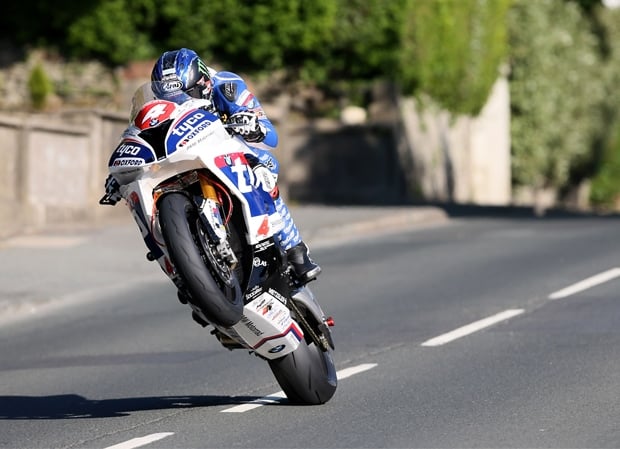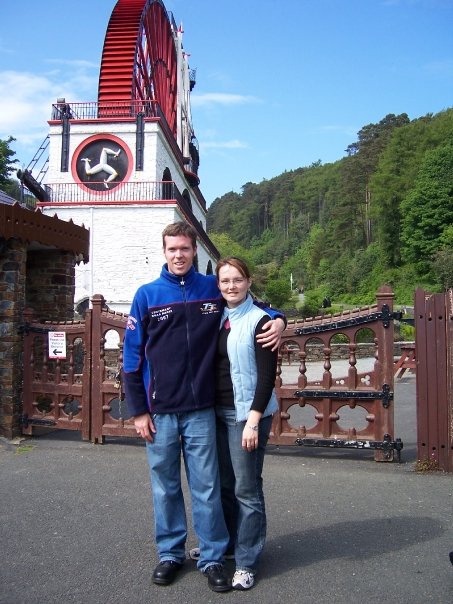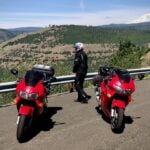A Fan Reflects On Attending The Greatest Race On The Planet
At some point in the future, as we look back on the year 2020, there will be several asterisks noting that the pandemic interrupted everything from sporting events to concerts and conventions. We are all facing that harsh reality, including those of us in the motorcycle community who look forward to the annual races and rallies. Yet for me, it was the cancellation of one of the sport’s most renowned contests that really hit home, specifically the legendary Isle of Man TT.
Viewed as one of the greatest spectacles in motorsports, the Isle of Man Tourist Trophy is an annual racing series held on a small island in the Irish Sea. While the picturesque setting is a unique place to hold such a thrilling competition, the fact that they run the event on 37+ miles of civilian roads makes it truly one of a kind. There was a time (from 1949-1976) when a trip to the Isle of Man was a fixture on the GP circuit, but as speeds increased and safety became a growing concern the GP organizers opted to skip TT in favor of the British Grand Prix. As a result, the TT lost a bit of its international acclaim as coverage dropped off significantly, especially here in the United States. Yet, for true fans of motorcycle racing, the Isle of Man has always been viewed as hallowed ground.

I was first introduced to the TT via the motorcycle magazines I subscribed to in my youth. They would often include feature articles in which one of their writers would describe a pilgrimage to the TT. They would regale readers with stories about the ferry ride across the calm blue waters of the Irish Sea and the first glimpse of Snaefell Mountain peering above the waves in the distance. Once on the island, these wayward scribes would continue to opine about the unpredictable weather, the quirky names given to specific locales on the track, and most of all, the courageous racing taking place along the Mountain Course. This interment access to the event sparked my curiosity, so I set out on a mission to learn more. Now, I can’t remember if I ordered my first VHS/DVD from Whitehorse Press (an outfit I have missed every day since they closed in 2017) or straight from Duke Video in the United Kingdom. Regardless, I recall ordering several videos and watching them in rapid succession. I saw footage dating back to the earliest races at the turn of the 20th century and proceeded through to contemporary competition. I was utterly amazed and aspired to one day make the trip myself to see those elite riders race up the mountain.
Years would pass before I would have such an opportunity, but in 2006 an organization I worked with (the International Journal of Motorcycle Studies) proposed the idea of holding a conference on the Isle of Man during Practice Week. These preliminary events (or practice sessions) are held the week before the actual TT races and they give competitors a chance to run the course and set up their machines. I expressed my STRONG support for this idea and the group ultimately decided to host a scholarly conference in May 2007 as part of the centennial celebration of the Isle of Man TT. I was going, no matter the cost or the logistical obstacles, I was definitely going.
Determined to make it to the Isle of Man I began planning for the trip, which is undoubtedly one of the biggest hurdles for Americans wishing to witness the TT for themselves. Most European travelers, especially those from the United Kingdom and Ireland, travel to the Isle of Man by booking passage on the aforementioned ferry. As a result, reservations are sold out months in advance. Ferries are offered from Heysham and Liverpool, England, as well as Dublin, Ireland and Belfast, Northern Ireland. After some research and price comparisons, my girlfriend and I opted to fly from Atlanta (our hometown) to Edinburgh, Scotland and then jump across to Douglas, the Isle of Man’s capital city, on a commuter plane. Some would say this was a less authentic journey, as passage on the ferry has long been associated with the TT, but I made this modest concession to simply get myself there. And air travel had its own perks as the flight attendant, who sat directly across from me on the tiny prop plane, reminded me that we were on an international flight from Edinburgh to Douglas, so the beer she handed me (without having to get out of her seat) was free of charge. The flight was so short; I barely had a chance to finish that beer before we landed.

Upon arriving, my girlfriend and I were greeted in the terminal by Cora, a local resident who would be hosting us during our stay. Given the influx of tourists that come for the races each year, the Manx government encouraged “home stays,” which meant Cora provided us with a room in her home for a nominal fee. She even shuttled us around a bit and made the most amazing English breakfast every morning — a feast that repeatedly carried me through to late afternoon. Her house was a quaint little cottage adjacent to an expansive pasture, which I mention because the occasional cow would join us as we ate breakfast in the sunroom overlooking the lush green fields. And while her home was lovely, the fact that it was located just a few blocks from Union Mills, one of the many signature spots along the Mountain Course, made it an ideal spot of us.
Once settled in after our long journey I finally realized I’d made it. I was standing on the Isle of Man, staying in the house of an ideal host, awaiting the races that would soon begin. The anticipation grew as we headed into Douglas for the first practice session. We figured the most suitable place to begin watching the racers was at the historic start/finish line. So, Cora dropped us off in Douglas, and my girlfriend and I met up with some of our friends attending the conference. We explored the paddock and talked with a few of the racers and crew members. The access was phenomenal and the racers were more than willing to chat with us and answer questions. Once practice was underway, we decided to head toward Bray Hill. By this point on the course, the bikes have had a chance to get up to speed and the screaming exhaust note of four-cylinder super bikes running wide open can be heard for miles as the machines approach and then roar past in the blink of an eye. As someone who has attended MotoGP races, as well as countless AMA events, my in-person introduction to the TT was unlike anything I’ve ever witnessed in motorsports. And the rest of our stay was equally exhilarating. During the day, my girlfriend and I would explore the island, as we embarked on excursions to areas like Laxey to see their world-famous waterwheel, as well as Peel to survey the ruins of a Viking castle. These expeditions would have made for a splendid vacation on their own, but add nightly motorcycle racing to that equation and I was in absolute heaven.

The most amazing aspect of the racing was the access we had to the track. Since the races take place on civilian roads, they allow spectators to line the streets as racers rush by at speeds approaching 200 mph. Volunteer marshals are quick to point out if you are standing too close, as they attempt to maintain a safe environment despite the rather obvious dangers. We also found the marshals to be valuable guides throughout our stay, as they would often share details about the track and suggest the best vantage points along the circuit. In addition to Bray Hill and Union Mills, my friends and I made it to Ballacraine, Creg-ny-baa (although practice was suspended that evening due to weather), Hillberry, Signpost Corner, and Governor’s Bridge. We also enjoyed a bus tour hosted by Nick Jefferies, a competitor with an illustrious history on the Isle of Man. His insights about the terrain and the nuances regarding specific corners helped us understand how these riders approach the rigors of racing the TT. The races are mind blowing to watch, especially in person, and I was grateful to have a chance to speak with riders like Nick to get a sense of how they navigate the course and deal with the tremendous risk. Riders lose their lives every year competing on the Isle of Man, as the margin for error is razor thin. Yet, knowing the inherent dangers, these racers return each year to once again attack the Mountain Course and strive for an elusive win. And while I respect motorcycles racers of all forms, having witnessed the TT for myself, I will always hold these competitors in a class of their own.
Unfortunately, we’ll have to wait until next year to see these riders venture out on the Mountain Course again. This is not the first time the races have been cancelled, as two world wars and an outbreak of foot and mouth disease (in animals) have interrupted the event in the past, but each time the racers returned and did so in glorious fashion. So, with signs of other motorcycle races returning this year, including MotoGP in July and World Superbike in August, and with MotoAmerica already underway there is definitely hope on the horizon. For anyone considering a venture to the Isle of Man, I cannot recommend it highly enough. This is a special setting in the world of motorsports with a rich history that is embraced throughout the island. The Manx people take great pride in the TT and are phenomenal hosts, and I can only imagine that when the pandemic breaks, they will be excited to welcome racers and race fans back to their splendid island in the Irish Sea.
Christian Pierce
Instagram: @motorcycle_prof
*photos by Christian Pierce and IOMTT.com























0 Comments